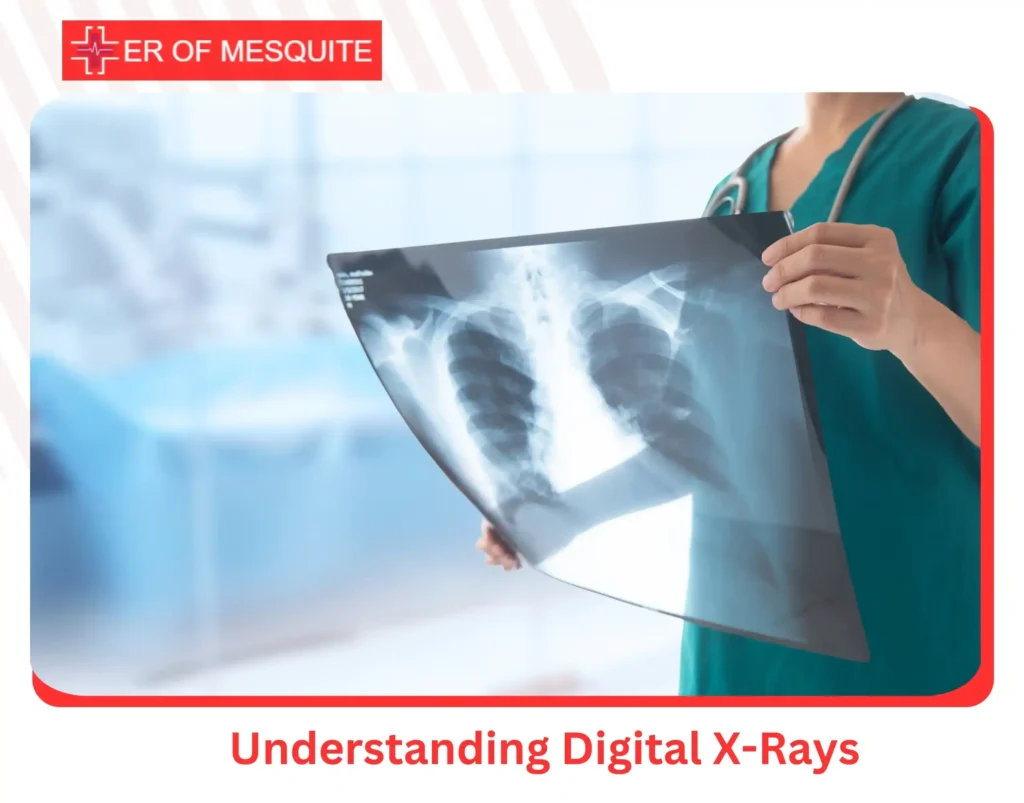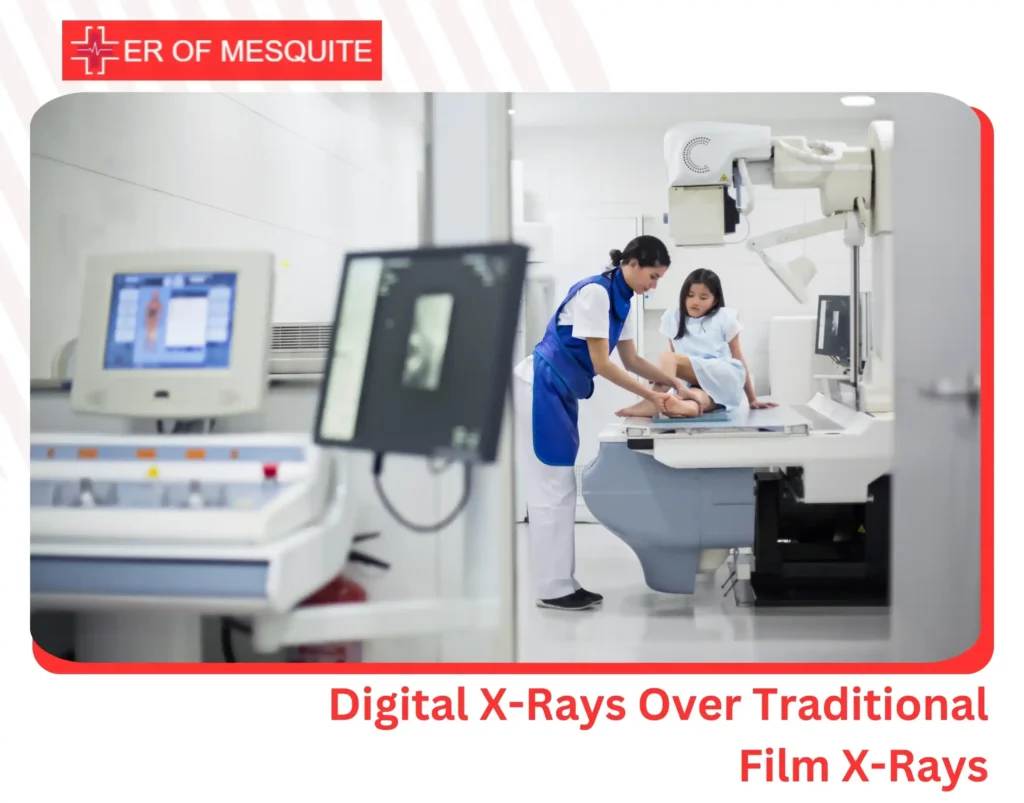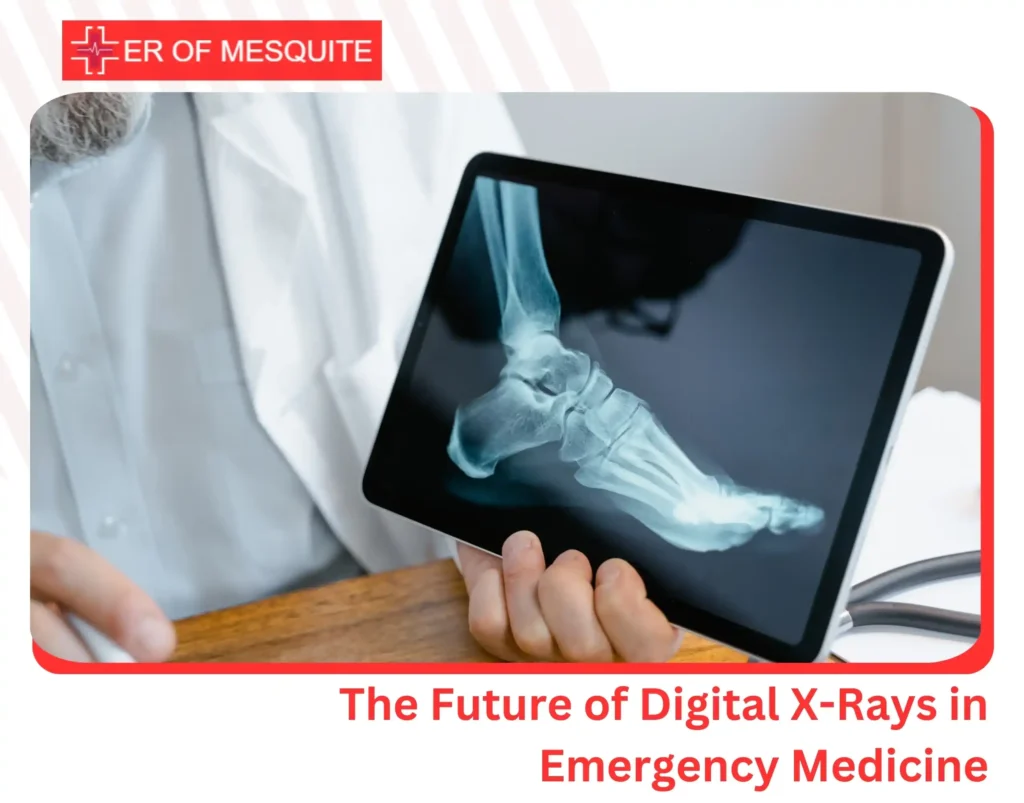When you’re in pain, every minute spent waiting for imaging results feels like hours. Digital x-rays eliminate this wait time by providing instant answers about what’s wrong with your body.
With digital x-rays, emergency physicians can spot tiny fractures, fragments, and foreign objects that traditional machines missed. This matters when something as small as a hairline crack can mean the difference between proper healing and weeks of complications.
At ER of Mesquite, we use digital x-rays because seeing problems clearly means fixing them correctly the first time. Better images mean better decisions about your care, without the waiting that once defined emergency medical imaging.
Understanding Digital X-Rays
Digital X-rays use specialized sensors instead of photographic film to capture images of the body’s internal structures. These images are then processed and displayed on a computer, allowing radiologists and emergency physicians to analyze them instantly.
This technology enhances radiology services by eliminating the need for chemical film processing, reducing exposure to radiation, and enabling better image storage and sharing.
Key Features of Digital X-Rays:
- Faster Image Processing: Results are available within seconds, reducing wait times in the ER.
- Lower Radiation Exposure: Compared to traditional X-rays, digital technology minimizes radiation doses, making it safer for patients.
- Enhanced Image Quality: Digital images can be adjusted for contrast and brightness, improving diagnostic accuracy.
- Easy Storage and Sharing: Digital files can be stored in hospital databases and shared instantly with specialists when needed.
The Role of Digital X-Rays in Emergency Diagnosis
In emergency medical environments, digital X-rays are essential for pinpointing fractures, identifying infections, and diagnosing ailments related to the chest, abdomen, and other regions.The ER of Mesquite uses digital X-ray technology to ensure quick and precise evaluations.
Diagnosing Bone Fractures and Dislocations
One of the primary applications of digital X-rays in the ER is spotting broken bones and dislocated joints. The high-definition images enable doctors to evaluate the injury’s severity and choose suitable treatments, such as casting, splinting, or surgery. Besides, digital images can be enlarged or enhanced to reveal hairline fractures that might be overlooked with conventional X-ray films.
Evaluating Chest Conditions
Digital X-rays are critical in diagnosing issues that impact the lungs and heart. During emergencies, they assist in identifying:
- Pneumonia: X-ray visuals show lung infections and fluid accumulation.
- Collapsed Lung (Pneumothorax): Healthcare providers can swiftly detect air leaks that affect breathing.
- Heart Enlargement: Digital X-rays help evaluate heart-related ailments like congestive heart failure.
By providing fast imaging results, emergency doctors can commence timely treatments for critical respiratory and cardiac conditions.
Detecting Internal Injuries
Individuals involved in traumatic accidents, such as vehicle collisions or falls, frequently need digital X-rays to examine internal injuries. These scans assist physicians in identifying fractured ribs, spinal injuries, or internal bleeding. The capacity to process images instantaneously guarantees that life-saving procedures are not postponed.
Diagnosing Abdominal and Digestive Issues
In instances of intense abdominal discomfort, digital X-rays aid emergency physicians in detecting conditions such as:
- Bowel Obstructions – Blockages that hinder normal digestion.
- Kidney Stones – Hard formations that create severe pain and necessitate medical care.
- Ingested Foreign Objects – Especially in children, digital imaging assists in finding and evaluating swallowed items.
Timely imaging allows ER specialists to determine whether non-invasive management is possible or if emergency procedures are required.
Digital X-Rays Over Traditional Film X-Rays
The transition from film-based X-rays to digital X-ray technology has greatly enhanced emergency medical services. Some primary benefits include:
Quicker Diagnosis and Treatment
Traditional X-rays require time-consuming film development, whereas digital X-rays provide instant results. This rapid turnaround is essential in emergency settings where every second counts.
Enhanced Image Quality and Precision
Digital imaging provides better clarity, simplifying the identification of small fractures, infections, and internal injuries. Radiologists can modify brightness and contrast for improved visibility, lowering the risk of misdiagnosis.
Lower Radiation Exposure
Digital technology uses fewer radiation doses compared to traditional film X-rays, making it a safer option for regular imaging, especially for children and expecting mothers.
Improved Data Storage and Access
Radiology services using digital technology can keep patient records stored electronically. This minimizes the need for physical storage and allows doctors to quickly access previous imaging records. Digital storage is especially helpful for patients with chronic illnesses or those needing follow-up care.
Simple Sharing with Specialists
Digital imaging promotes smooth communication between emergency departments, radiologists, and specialists. If additional assessment is necessary, the digital files can be transmitted electronically to experts without delay, ensuring quicker and more precise diagnoses.
The Future of Digital X-Rays in Emergency Medicine
As technology continues to advance, digital X-ray systems are likely to become increasingly sophisticated. Some upcoming trends include:
- AI Integration: AI-driven analysis may aid radiologists by identifying abnormalities and expediting the diagnostic process.
- Portable and Wireless X-Ray Systems: Mobile digital X-ray units enhance accessibility, enabling imaging to be conducted at the bedside or in remote areas.
- 3D X-Ray Imaging: Breakthroughs in 3D imaging deliver more detailed perspectives of fractures and internal structures, enhancing surgical planning and accuracy.
These advancements will further enhance the effectiveness of digital X-rays in emergency medicine, ensuring that patients receive faster, safer, and more accurate diagnoses.
Key Takeaway
Digital X-rays have changed the way emergency rooms diagnose and treat patients, making it easier to detect fractures, lung conditions, internal injuries, and more often within minutes. When every second counts, this advanced imaging technology helps doctors make faster and more accurate decisions, so you get the care you need without unnecessary delays.
The Emergency Room in Mesquite is committed to providing advanced radiology services to support quick and effective emergency care. If you ever face a serious injury or concerning symptoms, our team is available 24/7 to provide expert medical attention when you need it most.
FAQs
What is the basic principle of x-ray?
X-rays work by passing through the body. Bones block more X-rays and show up white, while softer tissues let more rays pass through and appear darker.
What frequency are x-rays?
X-rays have very high frequencies, much higher than visible light, and their waves are incredibly short, too small to see with the naked eye.



